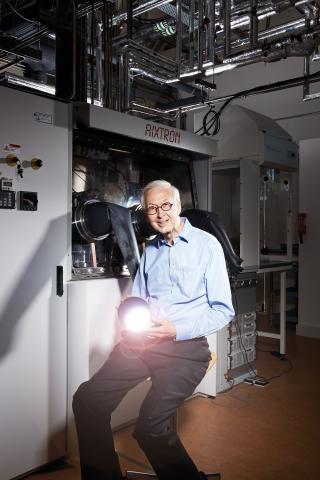Colin talks about his research, the founding of the GaN group and the future of GaN.
Download Colin's researcher profile as a PDF
Contact details and more information on Colin's research
How did you get interested in GaN research?

I first got interested in GaN research in about 1995, and in 1997 I had an EPSRC grant on Optimising Blue Light Emitters in which I compared two possible candidates for emitting blue light: gallium nitride and zinc selenide. We obtained gallium nitride quantum well structures from Nottingham University and zinc selenide from Heriot-Watt. After one year, it was clear to me that gallium nitride was going to be much better than zinc selenide, so at that point I abandoned zinc selenide and concentrated on gallium nitride.
How was the Cambridge Centre for Gallium Nitride formed?
In 1998, I did some work with Thomas Swan Scientific Equipment Ltd (which was taken over by Aixtron) who made GaN growth reactor. They were so pleased with our collaboration that they donated to me a new GaN growth reactor, which was worth about £750,000. The donation was on the condition that I obtained the money for installing this reactor and also that I obtained the running costs and the people to operate it. So I wrote a large EPSRC proposal, which was funded. When we got this growth reactor and this major EPSRC grant in 2000, I decided to set up the Cambridge Centre for Gallium Nitride.
What is your role in the GaN Group?
In 2000, the GaN group was very small, containing a grower, an electron microscopist, a technician and me. We had to catch up with the rest of the world in GaN, which we did! The GaN Group now contains about 30 people. We have wonderful people in the GaN Group. Rachel Oliver runs many projects and is an outstandingly good scientist. I run some other projects and I spend a lot of time writing grant proposals, some of which I lead, some of which Rachel leads. We collaborate with lots of other universities, and so they will lead some of these projects and we will be partners. David Wallis has recently started as an EPSRC Manufacturing Fellow in the Group and is already running some projects. He is an outstandingly good scientist with a lot of industrial experience. So we have a large group and it is a pleasure to be involved in it.

What do you like best about working in the Group?
I like interacting with the people in the Group and I also like thinking about new things to do. We have been very successful in exploiting our research. We developed GaN LEDs grown on 6-inch silicon wafers, which reduces the cost of LEDs. Our technology has been taken up by Plessey. They are manufacturing LEDs in Plymouth, UK, based on our technology, and they have sold millions of them. They have recently raised a lot more funding to create more jobs in Plymouth. Having one’s research exploited is really good. And another thing I like is that this is really useful research: LEDs will save over 10% of all the electricity we use, and save 10% of carbon emissions if that electricity is from power stations. So this is something that is very beneficial to humanity.
Where do you see gallium nitride in the future?
I believe that gallium nitride is the most important semiconductor since silicon. At the moment GaN is having a huge impact on lighting. I think in the next 10 years gallium nitride lighting will dominate lighting throughout the world, in street lights, homes, offices and everywhere. GaN power electronic devices are now coming along. They are perhaps 5 or 10 years behind GaN LEDs, but they will save another 10% of electricity because they are so efficient. If you add some aluminium to the gallium nitride, you can produce deep UV radiation, which kills all bacteria and viruses. This could save millions of lives by purifying water in the developing world and also be very useful in the UK: it is much better than using chlorine to purify water. So there are a huge number of applications for gallium nitride. In addition, GaN lighting will improve the health of all of us because in the future we will have optimised lighting in our homes and offices, which mimics sunlight. It will be like getting sunlight indoors. This optimised lighting will also improve productivity at work and productivity at school. GaN is an amazing new material, which is going to have a huge impact on the world in the next 20 years.



